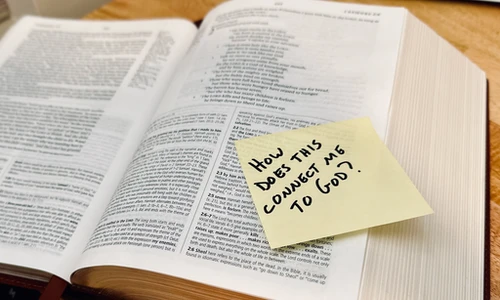Being Renewed In Knowledge
Do not lie to one another, seeing that you have put off the old self with its practices and have put on the new self, which is being renewed in knowledge after the image of its creator.
Previously, we saw how the cycle of identifying your sin, recognizing your need for Jesus, going to Jesus in faith with worship and wonder, and receiving forgiveness, is circular, not linear.
And we saw, although I didn’t lay it out explicitly, that you can enter that circle at any point. We often talk today as if there is a rigid progression from the conviction of sin to faith in Jesus to forgiveness to sanctification, but that’s a dramatic oversimplification.
Most importantly for the Christian, this cycle repeats itself. Especially as our lives change, we recognize new sin, we re-awaken to our need for Jesus, we renew our faith, and we are forgiven again and again.
Today, we see another cycle in Christian life, one that, like that one, has its beginning in Jesus and draws on His power to continue. And like the other, we may enter it at any point, although we sometimes think about it as if it’s the same for every believer.
If the first cycle is the cycle of forgiveness, this is the cycle of sanctification.
“Sanctification” is just a big word that means “becoming like Jesus.” Its root is “sanctify,” which means to make sacred, set apart, holy; we might also translate it progressively as “becoming holy.” (Moses (Leviticus 11:44), Jesus (Matthew 5:48), and Peter (1 Peter 1:16) all use this second interpretation.)
“Sanctify” also kind of sounds like “saint,” and indeed this is the process of becoming a saint. Not a Catholic saint, with an official proclamation and a feast day and all the earthly trappings of sainthood, but an ordinary Christian saint, one of the body and family of Christ, the ones we sing about “when the saints go marching in.” You didn’t think that song was just about Mary and Peter and Paul, did you? It’s about you.
Before we get any further into what it means to be sanctified, to be made holy, let’s look at what Paul tells us this cycle looks like.
If, he says (Colossians 3:1), you have died and been raised with Christ—but hold on, that’s too much already. We need to back up to Colossians 2 and ask what Paul means by “died.” There are four deaths available here:
- Death in sin. Paul says in Colossians 2:13 that we were (or are) “dead in our trespasses”, the consequence of the original sin of Adam and Eve. Our fallen selves are dead in the sense that they are disconnected both by Adam’s sin and by our own from the eternal life of Christ in which we were created way back in Genesis 1:27. Paul also calls this death the “uncircumcision of the flesh”—he means that we have not yet been set apart for God. Paul of all people doesn’t support, for most, physical circumcision1; instead, he uses the dichotomy of circumcision and uncircumcision to identify those who have given their lives to Christ and those who have not.
- Death to sin. This death Paul refers to just afterward, in Colossians 2:20, saying we must “with Christ…die to the elemental spirits of the world.” Those spirits being “the rulers…the authorities…the cosmic powers over this present darkness…the spiritual forces of evil in the heavenly places” (Ephesians 6:12), Satan and his minions that walk and rule the earth. To them, in Christ, we must die; we must give our lives to Jesus instead of to them. Which leads to the odd-sounding idea that, because we are dead in our trespasses, we should die to them so that we may live with Christ.
- Death of the body. This death is the normal death we mostly mean when we talk about someone dying. But it’s an important one, because “it is appointed for man to die once, and after that comes judgment” (Hebrews 9:27). So physical death is a part of our spiritual journey.
- Death of the spirit. This death, also called the “second death” (Revelation 21:8), is the final end of a soul apart from Jesus in eternity. We understand very little about the nature of this death, but we can be sure that it is not to be desired, but to be run from in terror.
Back to Paul. If, he says, you have died to sin and been raised with Christ—now we know that is the death he means, type 2—”seek the things that are above” (Colossians 3:1,2).
A person who is dead in sin (type 1) fixes their minds on earth: power, lust, greed, hunger. But a person who is dead to sin should instead lift up their eyes beyond the things that will pass away, to the heavenly things that are eternal, namely Jesus. For, he says, you have died (type 2).
A dead person does not see any more; your life is now “hidden in Christ” (Colossians 3:3), so when you open your eyes, you are in heaven, and it should fill your mind, squeezing out all these temporary things down here on earth.
Therefore—the circle starts here, by the way—therefore, “put to death what is earthly in you” (Colossians 3:5).
Oh, Paul. Why do you do this to us.
“If you have died to these earthly things, then put them to death.”
We’re circular already, and we’re on step two. (It’s a very small circle.)
This is yet a fifth usage of the word “death,” but I don’t list it with the others because this death is not for you but for all these things in you: “sexual immorality, impurity, passion, evil desire, and covetousness, which is idolatry…anger, wrath, malice, slander, and obscene talk from your mouth” (Colossians 3:5,8).
Let’s keep going and see what happens.
To put these things to death is to murder them. To destroy them. To utterly, violently remove them from your life. Paul’s language is deliberately extreme, because the consequences of sin are extreme. We are to make war against sin, not just deny it every once in a while.
Ephesians 6 above showed us what we’re fighting against; a few verses later, it shows us how to dress for battle. War and murder are serious deeds for serious Christians, and Paul isn’t kidding. Put sin to death in your life.
Do all these things, he says, because you have “put off the old self…and have put on the new self” (Colossians 3:9–10).
Now look, Paul, if I have already put off the old self “with its practices”, then why are all these things still alive in me that I must put to death? If I have put on the new self, where are these sins coming from? Does my new self have the same sins?
What even is this new self? I know the old self is dead in sin (type 1), and the new self is dead to sin (type 2), which means it’s alive in Christ, but… also the new self seems to have a lot of work to do? If it’s still fighting these battles, it seems a bit unfit to be “hidden with Christ in God” (Colossians 3:3).
Well, fortunately, Paul loves lists. I mean, he loves lists. So far today, he gave us two lists of sins in four verses (Colossians 3:5–8), and then he added one more item (Colossians 3:9) for good measure.
But those were lists of sins, and Paul also has ideas for what to replace them with:
Put on then, as God’s chosen ones, holy and beloved, compassionate hearts, kindness, humility, meekness, and patience, bearing with one another and, if one has a complaint against another, forgiving each other; as the Lord has forgiven you, so you also must forgive.
Wait, he’s not done:
And above all these put on love, which binds everything together in perfect harmony.
Hold on, still going:
And let the peace of Christ rule in your hearts, to which indeed you were called in one body.
Any more, Paul? Or are you…
And be thankful.
Okay. Phew.
So that’s what the new self looks like.
Now we have all the steps. We start off dead in sin (type 1), and then we become dead to sin (type 2), and then we kill all those sins (which are already dead?), and we put off our old body (which is also already dead), and we put on our new body (which, finally, is the only thing in this whole passage that is alive, and its life comes from Christ, the source of life).
But any Christian knows that this path is insane. Laughable. Which Christian has actually put off the old body and put on the new? Which of you has never lied or lusted, but always been compassionate and thankful?
Anybody?
Those of you raising your hands, please put them back down.
I said earlier this is an ongoing process. That’s why I refer to it as a cycle—not just because it’s circular, but because it repeats. And it intersects with the other one, the cycle of forgiveness. That one is about recognizing our need for Jesus when we inevitably slide backward; this one is about striving to more forward to the holiness Paul describes in this chapter.
And just as with forgiveness, where you do your best to avoid sin, and then confess and repent when you fall, with sanctification, you do your best to take one more step into what we are meant to be.
Let’s finish with a few additional thoughts on this cycle.
How, apart from Paul’s list here, do we discern what is holy?
Do not be conformed to this world, but be transformed by the renewal of your mind, that by testing you may discern what is the will of God, what is good and acceptable and perfect.
In Colossians, we are being “renewed in knowledge”—and as we saw yesterday, renewal in knowledge should mean renewal in obedience. In Romans, our minds are not limited by the “good” of this world but continually transformed to understand what holiness looks like, and then to achieve it.
Paul sends the same word to the Ephesians:
…put off your old self, which belongs to your former manner of life and is corrupt through deceitful desires, and to be renewed in the spirit of your minds, and to put on the new self, created after the likeness of God in true righteousness and holiness.
Again, renewing the mind is linked with both repenting of your former life and moving toward a life of “true righteousness and holiness.”
A common thread through all of these comments and commands around renewal, dying to sin and living with Christ, is their ongoing nature. Sanctification, renewal, is not an event but a process.
And the response is the same as it was last time: every day, wake up convinced you will follow God into holiness and grow closer to the image of your creator. And one day—you will.
-
Most simply, because it’s a stumbling block, and might make you think, as the Jews did, that simply because your flesh was marked, your heart and soul also were marked. Being Abraham’s physical descendant is not enough; you must instead be his child by faith. But note that Paul did circumcise Timothy (Acts 16:3) when he sent him to the Jews. ↩



